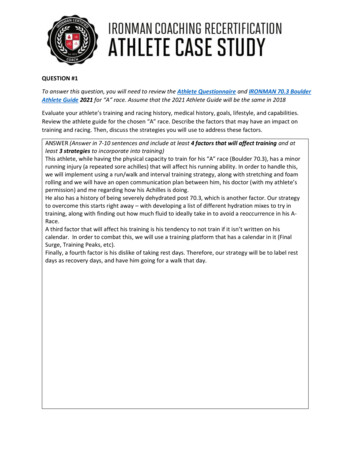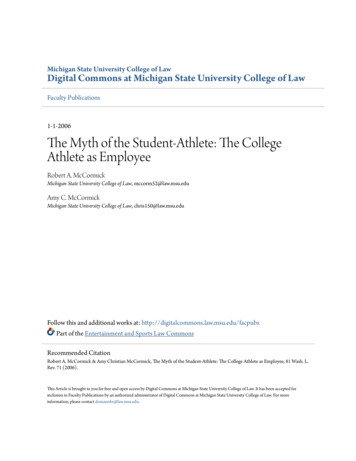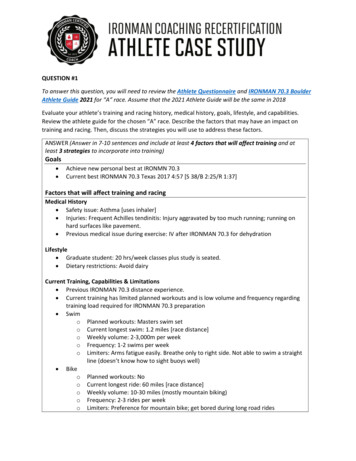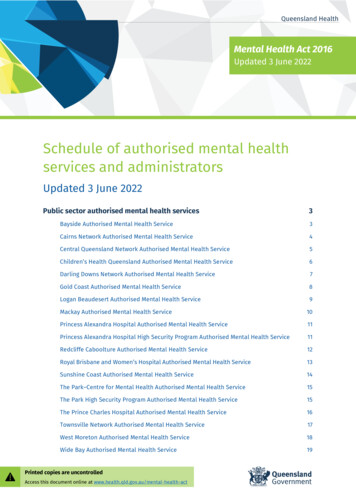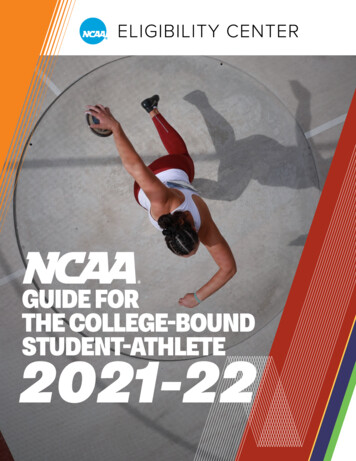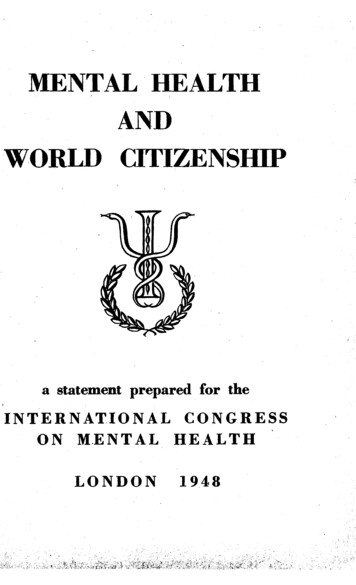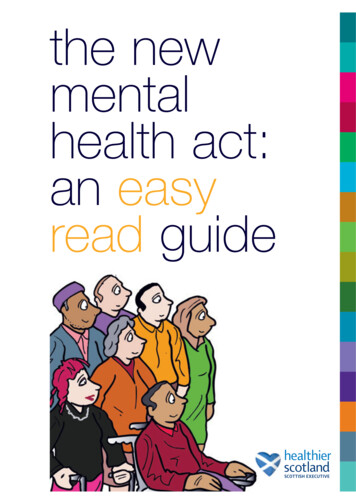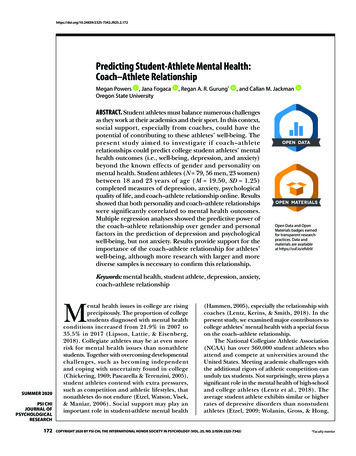
Transcription
cting Student-Athlete Mental Health:Coach–Athlete RelationshipMegan Powers , Jana FogacaOregon State University, Regan A. R. Gurung*, and Callan M. JackmanABSTRACT. Student athletes must balance numerous challengesas they work at their academics and their sport. In this context,social support, especially from coaches, could have thepotential of contributing to these athletes’ well-being. Thepresent study aimed to investigate if coach–athleterelationships could predict college student athletes’ mentalhealth outcomes (i.e., well-being, depression, and anxiety)beyond the known effects of gender and personality onmental health. Student athletes (N 79, 56 men, 23 women)between 18 and 23 years of age (M 19.50, SD 1.25)completed measures of depression, anxiety, psychologicalquality of life, and coach–athlete relationship online. Resultsshowed that both personality and coach–athlete relationshipswere significantly correlated to mental health outcomes.Multiple regression analyses showed the predictive power ofthe coach–athlete relationship over gender and personalfactors in the prediction of depression and psychologicalwell-being, but not anxiety. Results provide support for theimportance of the coach–athlete relationship for athletes’well-being, although more research with larger and morediverse samples is necessary to confirm this relationship.Open Data and OpenMaterials badges earnedfor transparent researchpractices. Data andmaterials are availableat https://osf.io/efvb9/Keywords: mental health, student athlete, depression, anxiety,coach–athlete relationshipMSUMMER 2020PSI CHIJOURNAL OFPSYCHOLOGICALRESEARCH172ental health issues in college are risingprecipitously. The proportion of collegestudents diagnosed with mental healthconditions increased from 21.9% in 2007 to35.5% in 2017 (Lipson, Lattie, & Eisenberg,2018). Collegiate athletes may be at even morerisk for mental health issues than nonathletestudents. Together with overcoming developmentalchallenges, such as becoming independentand coping with uncertainty found in college(Chickering, 1969; Pascarella & Terenzini, 2005),student athletes contend with extra pressures,such as competition and athletic lifestyles, thatnonathletes do not endure (Etzel, Watson, Visek,& Maniar, 2006). Social support may play animportant role in student-athlete mental health(Hammen, 2005), especially the relationship withcoaches (Lentz, Kerins, & Smith, 2018). In thepresent study, we examined major contributors tocollege athletes’ mental health with a special focuson the coach–athlete relationship.The National Collegiate Athletic Association(NCAA) has over 360,000 student athletes whoattend and compete at universities around theUnited States. Meeting academic challenges withthe additional rigors of athletic competition canunduly tax students. Not surprisingly, stress plays asignificant role in the mental health of high-schooland college athletes (Lentz et al., 2018). Theaverage student athlete exhibits similar or higherrates of depressive disorders than nonstudentathletes (Etzel, 2009; Wolanin, Gross, & Hong,COPYRIGHT 2020 BY PSI CHI, THE INTERNATIONAL HONOR SOCIETY IN PSYCHOLOGY (VOL. 25, NO. 2/ISSN 2325-7342)*Faculty mentor
Powers, Fogaca, Gurung, and Jackman Student-Athlete Mental Health2015; Wolanin, Hong, Marks, Panchoo, & Gross,2016). In a major study of college students, 28% ofthe female and 21% of the male student athletesreported symptoms of depression in the last 12months; 31% of male and 48% of female studentathletes reported symptoms of anxiety (Davorean &Hwang, 2014). Even more worrisome, a retrospective study from 2003 to 2012 showed that suiciderepresented the cause of 7.3% of NCAA studentathletes’ deaths during these nine seasons (Rao,Asif, Drezner, Toresdahl, & Harmon, 2015).Mental health is related to personal, interpersonal, and environmental factors, such aspersonality, social support, and life stressors(Hammen, 2005; Kotov, Gamez, Schimidt, &Watson, 2010; Oexle & Sheehan, 2020). Amongpersonal factors, gender (Storch, Storch, Killiany, &Roberti, 2005; Wolanin et al., 2016) and personality(Kotov et al., 2010) have been linked to mentalhealth in the past (Brewer, 1993). For example,a survey of 398 undergraduate students showedthat female student athletes had higher socialanxiety and depression than male athletes andnonathlete students (Storch et al., 2005). Theauthors noted that women may be exposed to agreater number of stressors during their collegiatecareers, internalizing these stressors more thantheir male counterparts, and feeling less satisfiedwith their overall collegiate experience (Storch etal., 2005). Another survey of 465 NCAA Division Istudent athletes found that women showed a risk1.84 times higher than men of reporting depressivesymptoms (Wolanin et al., 2016).Specific personality traits such as conscientiousness, extroversion, agreeableness, neuroticism, andopenness—or the Big Five traits—may also relate tomental health issues. Personality traits have beenlinked to competition anxiety (Binboga, Guven,Çatikkas, Bayazit, & Tok, 2012; Velikic, Knezevic, &Rodic, 2014) and social physique anxiety in athletes(Cangur, Yaman, Ercan, Yaman, & Tok, 2017). Ameta-analysis has also shown a link between theBig Five personality traits and anxiety, depressive,and substance abuse disorders in the generalpopulation, especially high neuroticism and lowconscientiousness (Kotov et al., 2010). Kotov etal. suggested that personality traits are stronglyrelated to psychopathology and should be takeninto consideration in research and clinical practice.Besides the importance of personality andgender, environmental factors can also have asignificant effect on mental health. Specifically,mental health issues among college student athletescan be linked to the number of daily stressors thatthey face, which in the long term could lead tomental illness, if not well managed (Davoren &Hwang, 2014; Hammen, 2005; Wenzel, Glanz, &Lerman, 2002). Student athletes must maintaina full course load, work out to meet the physicaldemands necessary to succeed, adapt to frequenttraveling for competition, and cope with injuries,while experiencing public pressure to perform(Ferrante & Etzel, 2009). Student athletes’ yearround training also results in athlete-specificphysical and psychosocial demands (Etzel et al.,2006). Overall, student athletes cope with variousstressors while adapting to the college environment and finding a well-balanced life betweensports, school, and social life (Beauchemin, 2014).Finding the right balance in student athletes’ livesis an added challenge because each individual isunique in the ways these aspects work togetherand the ways in which they do not (Whitehead &Senecal, 2019).Because of the significant impact of stress onmental health, interpersonal factors that helpathletes cope with these stressors should also beconsidered when analyzing student athletes’ mental health. A factor known to act as a buffer fromstress is social support (Lu et al., 2016; Wenzel etal., 2002). Social support has been operationalizedin different ways, and measures of perceptions,receipt, networks, and quality have all been relatedto health (Sarason, Sarason, & Gurung, 2001).Among college students, social support has beenrelated to lower risk of presenting depressive andanxiety symptoms (Hefner & Eisenberg, 2009;Merianos, Nabors, Vidourek, & King, 2013). Inaddition, student athletes who show higher socialconnectedness tend to have fewer symptoms ofdepression (Armstrong & Oomen-Early, 2009).Teammates’ social support negatively correlates todepression in female student athletes (Hagiwara,Iwatsuki, Isogai, Van Raalte, & Brewer, 2017).Despite the importance of social support forbetter mental health outcomes, the influence ofsocial support from the coach, and consequentlythe coach–athlete relationship, has not been satisfactorily explored (Felton & Jowett, 2013b; Felton& Jowett, 2017). Coaches can be an importantsource of support and can instill confidence intheir athletes (Lentz et al., 2018; Lu et al., 2016).Coaches can also be a source of stress with a poorcoach–athlete relationship adding stress in theathletes’ lives (Chyi, Lu, Wang, Hsu, & Chang,2018). In contrast, a good relationship could helpCOPYRIGHT 2020 BY PSI CHI, THE INTERNATIONAL HONOR SOCIETY IN PSYCHOLOGY (VOL. 25, NO. 2/ISSN 2325-7342)SUMMER 2020PSI CHIJOURNAL OFPSYCHOLOGICALRESEARCH173
Student-Athlete Mental Health Powers, Fogaca, Gurung, and JackmanSUMMER 2020PSI CHIJOURNAL OFPSYCHOLOGICALRESEARCH174in the identification of pre-existing mental healthissues and disclosure (Schary, 2019). Although therole of the coach has been studied, most researchfocuses on how coaches influence motivationand satisfaction (e.g., Langan, Toner, Blake, &Lonsdale, 2015; Raabe & Zakrajsek, 2017; Riley &Smith, 2011; Wu, Lai, & Chan, 2014). The coach–athlete relationship is strongly related to athletes’basic psychological needs and has the potential tobe helpful during physically, psychologically, andemotionally challenging times (Choi, Cho, & Huh,2013). Consequently, our working definition ofsocial support involves the provision of emotional,esteem, informational, and tangible aid by thecoach (Koh, Kokkonen, & Law, 2019).Research on social support in general, andfrom the coach in particular, reinforces the ideathat better understanding the coach–athlete relationship may help predict athletes’ mental health.For example, research on basic needs satisfactionprovided by the coach has shown that support froma coach predicts well-being outcomes (Davis &Jowett, 2014; Felton & Jowett, 2017). In one surveyof 215 athletes, perceived social support from thecoach predicted athletes’ basic needs satisfaction(Felton & Jowett, 2013a). Support from the coachhas also been related to other athlete well-beingfactors such as vitality, positive and negative affect,and physical self-concept (Felton & Jowett, 2013b).Coach–athlete attachment anxiety was related todifficulties in emotional regulation, which in turnwas linked to aggression, alcohol use, and psychological distress (Hebard, 2015). More researchis necessary to clarify the association betweencoach–athlete relationships and mental health.As illustrated, multiple variables may influencestudent athletes’ mental health, including gender,personality, and social support. Despite the apparent importance of the athletes’ relationships withtheir coaches to their mental health, this variablehas not been adequately studied in relation toimportant mental health outcomes, such as depression and anxiety. The aim of the present study wasto investigate if the variable coach–athlete relationship can predict student athletes’ mental healthafter controlling for the effect of personal factors.Specifically, we tested the extent to which coach–athlete relationships predicted student-athletemental health beyond the influence of gender andpersonality. Identifying specific variables that areconnected to student athletes’ mental health willhelp professionals develop more effective interventions to prevent mental health issues.MethodParticipantsThe sample consisted of 56 female and 23 malestudent athletes at a midsized Midwestern publicuniversity (Division I of the NCAA). Participantsranged between 18 and 23 years old (M 19.50,SD 1.25) and from college first-yearstudents to college seniors. Student athletes identified themselves as European American (n 77),African American (n 1), and Asian (n 1).Student athletes averaged 14.44 enrollment credits,which ranged from 12–18 credits (SD 1.69). Theaverage student athlete practiced 2.93 hours per day(SD 2.14; range 0–5). The average number of daysthe student athlete practiced each week was 5.77(SD 0.74; range 3–7). Participants took part in16 sports, and the highest represented sports wereswimming and diving (n 26), volleyball (n 11),and soccer (n 11).MeasuresStudent athletes answered demographic questionsconcerning age, class, number of course credits,ethnicity, and the number of hours of participationin their specific sport each day and each week.Participants also completed questionnaires abouttheir personality traits, coach–athlete relationship,and mental health.Personality. We measured personality with aquestionnaire based on the Big Five factors, the TenItem Personality Inventory (Gosling, Rentfrow, &Swann, 2003). It consists of 10 statements, two foreach factor, that are rated on a 7-point Likert-typescale ranging from 1 (disagree strongly) to 7 (agreestrongly). Sample statements included “extraverted,enthusiastic” and “open to new experiences, complex.” Gosling et al. demonstrated that the TenItem Personality Inventory has adequate validityand reliability, which makes it a good option todecrease the size of surveys involving Big Five traitswhile maintaining good psychometric standards.Given that each personality trait is only measuredwith two items, internal reliability measurementsare not commonly calculated.Coach–athlete relationship. The Coach–AthleteRelationship Questionnaire (CART-Q) (Jowett &Ntoumanis, 2004) was used to assess the coach–athlete relationship. Jowett and Ntoumanis (2004)have shown that this scale has good validity and reliability. This measure has 11 items and 3 subscales.The subscales consist of commitment (3 questions),closeness (4 questions), and complementarity(4 questions). The student athletes answered theCOPYRIGHT 2020 BY PSI CHI, THE INTERNATIONAL HONOR SOCIETY IN PSYCHOLOGY (VOL. 25, NO. 2/ISSN 2325-7342)
Powers, Fogaca, Gurung, and Jackman Student-Athlete Mental HealthCART-Q questions based on their relationship withtheir head coach. Sample questions include “I feelclose to my head coach” and “I respect my headcoach.” The student athletes selected a responsebased on a 7-point Likert-type scale, ranging from 1(strongly disagree) to 7 (strongly agree). The Cronbachα for CART-Q was .98.Mental health. To draw a comprehensiveassessment of the athletes’ mental health, we usedmeasurements of mental disorders (i.e., depressionand anxiety) and of a positive element of mentalhealth (i.e., psychological quality of life). Each scalehas been validated in previous studies and shown tohave convergent and divergent validity.Positive elements of health. WHO-Qualityof Life (WHOQOL-BREF) is a brief version ofthe World Health Organization Quality of Lifeassessment (The WHOQOL Group, 1998). Ithas been tested in a sample of people across 23countries, showing sound validity and reliability(Skevington, Lotfy, & O’Connell, 2004). The scaleconsists of 26 questions and 4 domains (physicalhealth, psychological health, social relationships,and environmental health), but only psychological health was used in the present study. Samplestatements included, “How much do you enjoylife?” and “How satisfied are you with yourself?”For Questions 1 through 4, responses ranged from1 (not at all) to 5 (an extreme amount). For Question5, the statements ranged from 1 (very dissatisfied)to 5 (very satisfied). For Question 6, the statementsranged from 1 (never) to 5 (always). Reliability washigh, Cronbach α .83.Negative elements of health. The Center forEpidemiological Studies-Depression Scale Revised(CESD-R; Eaton, Muntaner, Smith, Tien, & Ybarra,2004) consists of 20 statements on a 5-point Likerttype scale ranging from 1 (not at all or less than 1day last week) to 5 (nearly every day for two weeks).Sample items are comprised of “Nothing mademe happy” and “I felt like I was moving too slowly.”This scale has shown good validity and reliabilityand is vastly used in psychiatric epidemiology, withthe strength of being atheoretical (Eaton et al.,2004; Van Dam & Earleywine, 2011). The CESD-Rvalue that determines if an individual is consideredclinically depressed is a score of 16 or higher outof the total 20 questions. The Cronbach α for theCESD-R was .86.The Beck Anxiety Inventory Manual consistsof 21 statements regarding how the individualfelt within the past month (Beck & Steer, 1993).Participants use a 4-point response scale, rangingfrom 0 (not at all) to 3 (severely – it bothered me a lot).Sample statements included are “numbness ortingling” and “difficulty in breathing.” The BeckAnxiety Inventory Manual showed strong reliability with a Cronbach’s α of 0.89. A score of 1–21indicates low anxiety, a score of 21–35 indicatesmoderate anxiety, and a score greater than 36indicates high anxiety. Individuals scoring in therange of moderate to high anxiety should followup with a medical professional.ProcedureAthletes completed the questionnaires on Qualtricsduring the month of November. After approvalof the Institutional Review Board, the universityathletic department’s academic coordinator sentemails to every student athlete (n 247) andincluded an invitation to participate in the onlinesurvey. Seventy-nine athletes completed surveys fora 32% response rate. Participants gave consent toparticipate in the survey, provided the backgroundinformation requested, and completed each of thesurveys listed above in this report. Participants filledin their first and last names at the end of the surveyto allow clinical referrals based on clinical levels ofdepression or anxiety. Only the researchers hadaccess to the data.Data AnalysisWe used the Statistical Package for the SocialSciences for three major data analyses. First, weconducted descriptive analyses of all variables,both for the complete sample and separated bygender. Next, we correlated the major predictorvariables personality and coach–athlete relationship subscales with measures of mental health(depression, anxiety, and psychological quality oflife), controlling for gender. Finally, we used threehierarchical multiple regression analyses to assessif the coach–athlete relationship could predicteach of the major mental health measures beyondgender and personality. We entered gender andpersonality in the first step and coach–athleterelationship in the second to test if it predictedvariance in mental health variables over and abovegender and personality.ResultsTable 1 illustrates the mean and standard deviationsof all variables presented in the survey. We used anAnalysis of Variance (ANOVA) to assess if therewere significant differences between genders onthe mental health variables. All descriptive dataCOPYRIGHT 2020 BY PSI CHI, THE INTERNATIONAL HONOR SOCIETY IN PSYCHOLOGY (VOL. 25, NO. 2/ISSN 2325-7342)SUMMER 2020PSI CHIJOURNAL OFPSYCHOLOGICALRESEARCH175
Student-Athlete Mental Health Powers, Fogaca, Gurung, and Jackmanare shown in Table 1. Men and women varied onfive measures in the study. Men showed higherscores on the WHOQOL scale, F(1, 72) 4.08,p .047, and three measures of the coach–athlete relationship, and lower scores on emotional stability,F(1, 72) 11.18, p .001. Consistent with our focuson this important relationship, our results showmen reporting higher levels of complementarity, F(1, 72) 4.75, p .033, and commitment,F(1, 72) 5.88, p .018, on the CART-Q.Associations Between Major VariablesTable 2 shows partial correlations between eachof the mental health variables and the predictorvariables, controlling for gender. Results showmany significant, moderate correlations betweenthe variables examined. Consistent with the mainfocus of this article, the strongest associations areseen between well-being, depression, and the subscales of coach–athlete relationship. In addition,emotional stability correlated significantly withall mental health measures. It was positively andstrongly correlated with quality of life, and negatively and moderately correlated to depression andanxiety. The correlations supported the importanceof including measures of personality, especiallyemotional stability, and coach–athlete relationshipmeasures in the hierarchical regression analyses.TABLE 1Descriptive Characteristics for IndividualVariables by GenderVariableMale (n 23)M(SD)Female (n 56)M(SD)Ten Item Personality InventoryExtraversion9.36 (2.97)9.45 (2.69)Agreeableness8.73 (2.60)9.00 (1.96)Conscientiousness11.55 (2.22)11.59 (1.98)Emotional Stability*10.95 (2.36)8.73 (2.71)Openness10.73 (2.62)10.61 (1.88)55.52(15.09)45.66(17.24)Commitment16.29 (5.47)12.70 (5.77)Closeness23.05 (6.33)19.54 (7.23)Coach–Athlete Relationship Questionnaire*21.90 (5.33)18.22 (6.92)World Health Organization- Quality of Life*Complementarity23.95 (3.76)21.88 (4.00)Center for Epidemiological StudiesDepression Scale Revised10.20(14.11)13.79(11.18)6.15 (9.50)9.43 (7.31)*Beck Anxiety InventoryNote. * Indicates statistically significant (p .05) differences between gender.176A post-hoc power analysis showed that assuming amedium effect size and a standard significance levelof p .05, power was sufficient with our samplesize .74. Assuming a large effect between mentalhealth and coach–athlete relationship shows oursample has adequate power.Predicting Mental HealthThree hierarchical multiple regressions hadgender and personality inserted on the first stepand coach–athlete relationship on the secondstep. The first multiple regression had depressionas the dependent variable. In predicting depression, only the model including coach–athleterelationship as a predictor was significant, witha medium effect size, F(7,61) 2.22, p .045,R2 .21. The combination of gender, personality,and coach–athlete relationship predicted 21%of the variance in depression scores. Addingcoach–athlete relationship on the second stepof the hierarchical regression accounted for anadditional 15% of the variance in depression,ΔF(1, 60) 11.37, p .001, ΔR2 .15. Regardingspecific predictors, only coach–athlete relationship (β -.43, p .001) was a significant predictorof depression, where a stronger coach–athleterelationship was associated with lower depressionscores. Table 3 shows the values for all predictors.The second hierarchical regression, which hadpsychological quality of life as the dependent variable, also had only the second model as significant,with a medium effect size, F(7,61) 2.78, p .014,R2 .24. The model accounted for 24% of thevariance in psychological quality of life, withthe addition of coach–athlete relationship contributing to half of this variance (ΔR 2 .12),ΔF(1, 61) 9.39, p .003. Regarding specificpredictors, again, coach–athlete relationship wasthe only significant predictor (β -.38, p .003),where a stronger coach–athlete relationship wasassociated with higher quality of life scores. Table3 shows the values for all predictors.In the third hierarchical regression, anxiety wasthe dependent variable. Neither model was significant in predicting anxiety. Gender and personalityhad a statistically nonsignificant contribution of5% to the anxiety scores with a small effect size,F(6,60) 0.54, p .777, R2 .05, and the modelincluding coach–athlete relationship had a nonsignificant contribution of 11%, ΔF(7,59) 1.05,p .407, ΔR2 .11. We summarize the regressionanalyses in Table 3.COPYRIGHT 2020 BY PSI CHI, THE INTERNATIONAL HONOR SOCIETY IN PSYCHOLOGY (VOL. 25, NO. 2/ISSN 2325-7342)
Powers, Fogaca, Gurung, and Jackman Student-Athlete Mental HealthDiscussionThis study aimed to assess the associations betweencoach–athlete relationships and student athletes’mental health. It also aimed to analyze if thisassociation would be significant after accountingfor the influence of student athletes’ gender andpersonality. Our results provide a detailed pictureof the relationships between different measures ofmental health, a range of personality factors, andmost importantly, measures of the coach–athleterelationship. This section will discuss the findingsregarding the relationship of each of these variableswith different aspects of student athletes’ mentalhealth.The relationship between coaches and athletespresents itself as a major candidate for focus in thecontext of mental health of athletes (Lentz et al.,2018). Coaches’ relationship with their athletesshowed a clear association with psychologicalquality of life and depression and contributed tothe prediction of 15% of depression and 12% ofpsychological quality of life scores in this sample,after accounting for the effects of gender andpersonality variables. These are important findings,as they reinforce the need for coaches to invest onthe improvement of their relationships with theirathletes. Previous research has shown that thecoach–athlete relationship influences importantaspects of athletes’ performance and development(Prophet, Singer, Martin, & Coulter, 2017). In addition, the International Sport Coaching Framework(2013) includes building relationships in its list ofcoaching competencies. It is one of the few times,however, that this variable is related to aspects ofathletes’ mental health.Even though the link between coach–athleterelationship and depression in athletes has not beenstudied extensively in the past, it is not surprisingthat this relationship may exist. Lentz et al. (2018)suggested that the athletes’ relationships with theircoaches could represent a source of support amidthe many stressors that college student athletesendure. On most teams, the coach is the main pointof contact between the athlete and the university,and on some campuses the coach may be thegatekeeper for all interactions with a university.A coach and his or her approval or disapprovalcould also play a major role in the athlete’s psyche.Implicitly or explicitly the athletes’ prospects, playing time, and career, can hinge on the coach. It isnot surprising that the relationship with the coachcan play a major role in the athlete’s mental health.Further, a poor relationship with the coach couldbe a stressor in itself, not only negating support,but also generating more stress on top of the manypressures that student athletes already undergo(Lentz et al., 2018).Previous research (i.e., Davis & Jowett, 2014;Felton & Jowett, 2013b; Felton & Jowett, 2017) hasshown an association of athlete’s attachment styleand coach support with well-being outcomes such asaffect, vitality, and performance self-concept. In thepresent study, coach–athlete relationship was correlated to psychological quality of life and depression,besides predicting them over and above the effectsof personality and gender. These findings indicatethat the coaches’ behaviors and their relationshipwith their athletes may have a connection with theirTABLE 2Correlations Between Major Variables,Controlled by ss.14-.60.07Conscientiousness.22.00-.21Emotional ementarity.36**-.41**-.15Note. WHO World Health Organization. CESD-R Center for Epidemiological StudiesDepression Scale Revised. BAI Beck Anxiety Inventory Manual.*p .05. ** p .01. *** p .001.TABLE 3Summary of Multiple Regression Analyses for the Predictionof Depression, Anxiety, and Psychological Quality of LifeDepressionAnxietyPsychological QOLBSE B BSE B BSE B .06.27.03Emotional **1st Block2nd BlockC–A Rel.R2.21F2.22*.11.241.052.78*Note. QOL Quality of Life. C–A Rel. Coach–athlete relationship.*p .05. **p .01. ***p .001.COPYRIGHT 2020 BY PSI CHI, THE INTERNATIONAL HONOR SOCIETY IN PSYCHOLOGY (VOL. 25, NO. 2/ISSN 2325-7342)177
Student-Athlete Mental Health Powers, Fogaca, Gurung, and JackmanSUMMER 2020PSI CHIJOURNAL OFPSYCHOLOGICALRESEARCH178athletes’ mental health, beyond the effect of theathletes’ personality on their own mental health.However, further research with larger and morevaried samples (i.e., from various universities anddivisions) are needed to confirm the relationshipof these variables. In addition, future studies withlongitudinal or experimental designs could helpidentify if this relationship is causal or if there is athird confounding or mediating variable affectingthis association.Beyond the coach–athlete relationship, ourresults shed light on other aspects of studentathletes’ mental health. We found significantgender differences in quality of life scores andthat emotional stability was significantly correlatedto all measures of student-athlete mental health.In a meta-analysis that included 137 personalitytraits as correlates of subjective happiness andwell-being, DeNeve and Cooper (1998) foundthat among the Big Five factors, emotional stabilitywas the strongest predictor of happiness, and thatextraversion and agreeableness were good predictors of positive affect. However, emotional stabilitywas not a significant predictor in the hierarchicalmultiple regressions. These findings indicate that itmay be important to consider emotional stability’srole in student athletes’ mental health in researchand practice, but further research is necessary toestablish this connection with confidence.Our results are tempered by some importantlimitations. First, we acknowledge that differentteams have their seasons start and end at differenttimes of the year. Our data was collected at onepoint in the year and, although some teams werealready playing, others would only be practicing.The stress and related mental health issues wouldcorrespondingly be different. Second, teams varyin size. Whereas a swimming team may have manymembers and even many assistant coaches, a volleyball team will have a smaller number of players.Although we measured team membership, we didnot factor team size into our analyses. Both thesefactors are especially important when we note thatthis is a correlational study and we cannot measurechanges in athlete or coach behavior and resulting changes in mental health. Third, the sampleis relatively homogeneous, bei
SD 1.25) and from college first-year students to college seniors. Student athletes iden-tified themselves as European American ( 77), n African American ( 1), and Asian (n 1). n Student athletes averaged 14.44 enrollment credits, which ranged from 12-18 credits (SD 1.69). The average student athlete practiced 2.93 hours per day
